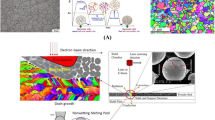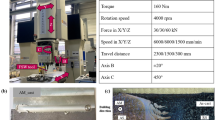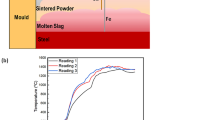Abstract
In general, thermal residual stress is generated in casting products as a result of non-uniform cooling, phase transformation from liquid to solid states, and thermo-mechanical constraints. Thus, understanding accurate stress distributions is important in designing a casting part to predict its real structural stability. However, the residual stress that occurs in the casting process is often not considered in the mechanical design process to reduce engineering efforts and time. We conducted a structural analysis that compares two cases with and without considering casting residual stress in large-scale sand castings and obtained significantly different results. We introduced an interfacing algorithm (casting-structural interface) to map the casting residual stress with structural stress and combined the results of finite different analysis for casting and finite element analysis for structural design. This work represents our preliminary studies on improving the design accuracy of a large-scale casting part and shows the importance of considering the casting residual stress. A difference of about 41% in maximal principle stress is obtained with and without considering the casting residual stress.
Similar content being viewed by others
References
B. G. Thomas, I. V. Samaraeskera and J. K. Brimacombe, Mathematical model of the thermal processing of steel ingots: Part II, Stress model, Metall. Tran. B, 18 (1) (1987) 131–147.
A. Grill, K. Sorimachi and J. K. Brimacombe, Heat flow, gap formation and break-out in the continuous casting of steel slabs, Metall. Trans. B, 7 (2) (1976) 177–189.
A. Grill, J. K. Brimacombe and F. Weinberg, Mathematical analysis of stresses in continuous casting of steel, Ironmak. Steelmak, 3 (1) (1976) 38–47.
T. C. Tszeng and S. Kobayashi, Stress analysis in solidification process: application to continuous casting, Int. J. Mach. Tools Manuf., 29 (1) (1989) 121–140.
R. Song, G. Dhatt and A. B. Cheikh, Thermo-mechanical finite element model of casting systems, Int. J. Numer. Meth. Eng., 30 (4) (1990) 579–599.
J. R. Williams, R. W. Lewis and K. Morgan, An elastoviscopalstic thermal stress model with applications to the continuous casting of metals, Int. J. Numer. Meth. Eng., 14 (1) (1979) 1–9.
R. H. Tien and O. Richimond, Theory of maximum tensile stresses in the solidifying shell of a constrained rectangular casting, J. Appl. Mech., 49 (3) (1982) 481–486.
K. H. Huebner, E. A. Thornton and T. G. Byrom, The finite element method for engineers, 3rd ed, Wiley, New York (1995) 3–5.
B. G Thomas, Stress modeling of casting process: an overview, Proceedings of the modeling of Casting, Welding and Advanced Solidification Process VI (1993) 519–534.
H. Y. Choi, J. N. Park and J. S. Lee, Quality engineering optimization of robot casting considering design robustness: Comparison with reliability, Int. J. Prec. Eng. Manuf., 14 (12) (2013) 2157–2163.
K. Jin, T. S. Jeong, T. S. Kim, N. S. Kim and B. G. Kim, Analysis and design for reducing residual stress and distortion after ejection of injection molded part with metalinsert, Int. J. Prec. Eng. Manuf., 15 (12) (2014) 2533–2542.
Y. H. Yang, C. Yarka, J. A. Cao and K.N. Ehmann, Feasibility of using copper(II) oxide for additive manufacturing, Int. J. Prec. Eng. Manuf., 15 (9) (2014) 1961–1965.
S. A. Argyropolous and M. Trovant, The implementation of a mathematical model to characterize mold metal inter face effects in metal casting, Can. Metall. Quart., 37 (3–4) (1998) 185–196.
G. Totten, M. Howes and T. Inoue, Handbook of residual stress and deformation of steel, ASM International (2002) 361–371.
H. M Si, C. D. Cho and S. Y. Kwahk, A hybrid method for casting process simulation by combining FDM and FEM with an efficient data conversion algorithm, J. Mater. Proces. Techno., 133 (3) (2003) 311–321.
C. Y. Kang and J. W. Liu, Study on residual stress of cylinder block casting by using an integrated FDM/FEM System, In modeling of casting, welding and advanced solidification processes VIII, The Minerals, Metals & Materials Society (1998) 771–775.
F. G. Boehmer and J. R. Fett, A Coupled FDM/FEM model for the continuous casting process, Int. J. Computer Appl. Techno., 7 (3–6) (1997) 214–228.
C.-H. Song, K.-B. Kwon, J.-Y. Oh, S. Lee, D.-Y. Shin and J.-W. Cho, Optimum design of the internal flushing channel of a drill bit using RSM and CFD simulation, Int. J. Prec. Eng. Manuf., 15 (6) (2014) 1041–1050.
Author information
Authors and Affiliations
Corresponding author
Additional information
Recommended by Guest Editor Sangho Park
Jae Hyun Yu is finishing his Ph.D. at Pusan National University. He received his M.A. (2011) in Mechanical Engineering from Pusan National University. His current research interests are Casting Structure Interface method in casting analysis.
Zhi jun Zhao is currently finishing his Ph.D. at Pusan National University. He received his M.A. (2014) in Mechanical Engineering from Kumoh National Institute of Technology. His current research interests are Micro-Scale Wrinkles and 3D Printing.
Changmin Son is a professor of mechanical engineering at Pusan Nation University. He earned his B.A. and M.A. at Pusan National University (Korea) in 1989 and 1991, respectively. He earned his Ph.D. at the University of Oxford (England) in 2005. He has worked on gas turbine heat transfer and aerodynamics.
Sang Hu Park is a professor of mechanical engineering at Pusan National University. He earned his M.S. and Ph.D. in mechanical engineering at Korea Advanced Institute of Science and Technology (KAIST, Korea) in 1996 and 2006, respectively. His research fields are the development of 3D printing process, mechanical design, and manufacturing technology, especially for multi-scale structures.
Rights and permissions
About this article
Cite this article
Yu, J.H., Zhao, Z.j., Son, C. et al. Improvement of structural design accuracy using a casting-structural interface (CSI) method in large-scale sand castings. J Mech Sci Technol 29, 5093–5098 (2015). https://doi.org/10.1007/s12206-015-1106-x
Received:
Revised:
Accepted:
Published:
Issue Date:
DOI: https://doi.org/10.1007/s12206-015-1106-x




